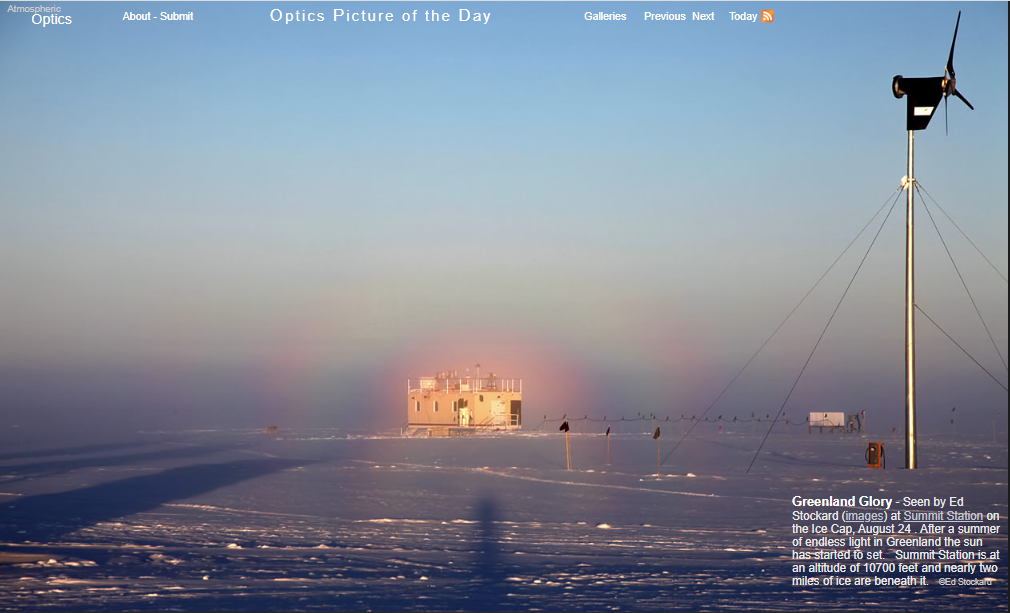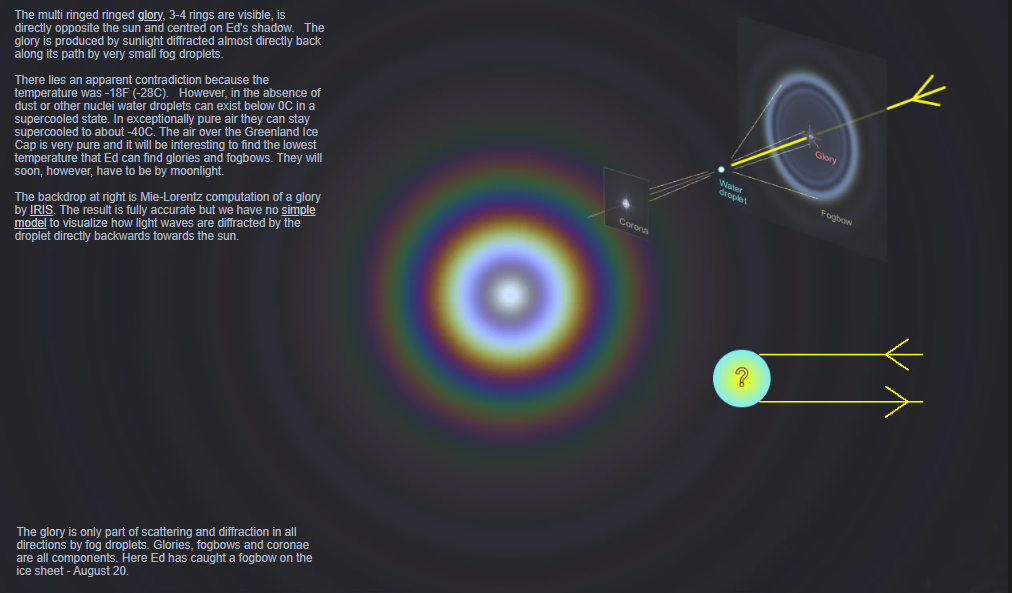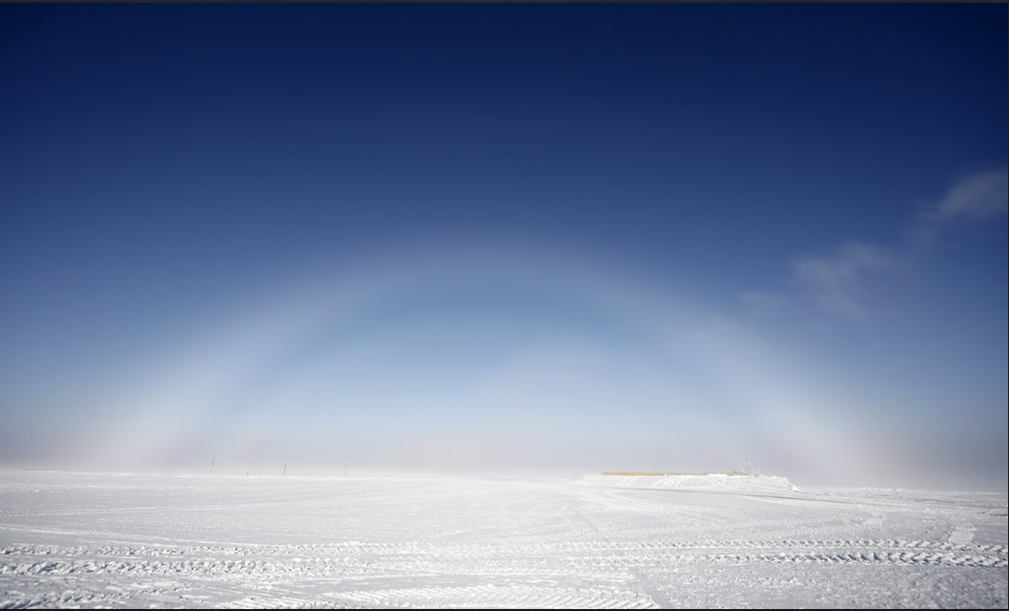OPOD - Greenland Glory
OPOD - Greenland Glory: Exploring the Enigmatic Atmospheric Phenomenon
Have you ever witnessed a breathtaking natural spectacle in the sky that left you in awe? Today, we delve into the mesmerizing world of atmospheric optics and focus our attention on a captivating phenomenon known as the Greenland Glory. This article aims to provide you with a more detailed and comprehensive understanding of this ethereal event, shedding light on its origins, characteristics, and the intriguing conditions under which it occurs.
Unveiling the Greenland Glory
The Greenland Glory is a remarkable optical phenomenon that manifests as a series of concentric rings encircling the shadow of an observer. It is best observed when one is positioned at a high altitude, such as Summit Station on the Ice Cap in Greenland. These enchanting rings, typically numbering three to four, appear directly opposite the sun, seemingly centered on the observer's shadow. The glory owes its existence to the diffraction of sunlight by minuscule fog droplets, which causes the light to be scattered back along its original path.
The Curious Case of Contradictory Temperatures
One might wonder how the Greenland Glory can be witnessed amidst freezing temperatures. Despite the apparent contradiction, it is possible for water droplets to exist in a supercooled state below 0°C (-18°F) in the absence of dust or other nuclei. In regions of exceptionally pure air, such as the Greenland Ice Cap, these droplets can remain supercooled until temperatures reach approximately -40°C (-40°F). This fascinating interplay between temperature and purity creates an ideal environment for the formation of glories and fogbows.
Exploring the Limits: Seeking the Coldest Glories and Fogbows
As we marvel at the captivating Greenland Glory, we are left with a lingering question: What are the lowest temperatures at which these atmospheric phenomena can be observed? Ed Stockard, the observer who captured the stunning images of the Greenland Glory, finds himself in a unique position to explore this intriguing aspect. Situated at an altitude of 10,700 feet, with a vast expanse of ice beneath him, Ed is poised to discover the coldest temperatures at which glories and fogbows can manifest. However, as the sun bids farewell for the season, his observations will soon rely on the soft glow of moonlight.
Peering into the Physics: Visualizing the Glory's Formation
While we are captivated by the beauty of the Greenland Glory, understanding its formation poses a challenge. The backdrop in one of the images, created using Mie-Lorentz computation by IRIS, provides an accurate representation of the glory. However, visualizing how light waves are diffracted by the fog droplets and directed backward towards the sun remains elusive. Scientists are yet to develop a simple model that allows us to grasp this intricate phenomenon fully.
Unveiling the Ensemble: Glories, Fogbows, and Coronae
The Greenland Glory is but one component of a larger ensemble of atmospheric phenomena involving scattering and diffraction by fog droplets. Alongside glories, other notable members of this captivating family include fogbows and coronae. A fogbow, similar to a rainbow, forms when sunlight interacts with water droplets suspended in fog. Coronae, on the other hand, are iridescent rings encircling the sun or moon caused by diffraction and interference of light passing through water droplets or ice crystals in the atmosphere.
Conclusion
The Greenland Glory stands as a testament to the awe-inspiring beauty and complexity of atmospheric optics. As we delve deeper into the world of natural phenomena, we uncover hidden marvels that challenge our understanding and ignite our curiosity. The enigmatic interplay between light, fog droplets, and temperature in creating these ethereal displays leaves us with a profound appreciation for the wonders of our natural world. So, the next time you find yourself gazing at the sky, remember to keep an eye out for the Greenland Glory, a dazzling spectacle that reminds us of the extraordinary intricacies that lie above us.

Greenland Glory - Seen by Ed Stockard (images) at Summit Station on the Ice Cap, August 24 . After a summer of endless light in Greenland the sun has started to set. Summit Station is at an altitude of 10700 feet and nearly two miles of ice are beneath it. ©Ed Stockard
The multi ringed ringed glory, 3-4 rings are visible, is directly opposite the sun and centred on Ed's shadow. The glory is produced by sunlight diffracted almost directly back along its path by very small fog droplets.
There lies an apparent contradiction because the temperature was -18F (-28C). However, in the absence of dust or other nuclei water droplets can exist below 0C in a supercooled state. In exceptionally pure air they can stay supercooled to about -40C. The air over the Greenland Ice Cap is very pure and it will be interesting to find the lowest temperature that Ed can find glories and fogbows. They will soon, however, have to be by moonlight.
The backdrop at right is Mie-Lorentz computation of a glory by IRIS. The result is fully accurate but we have no simple model to visualize how light waves are diffracted by the droplet directly backwards towards the sun.
The glory is only part of scattering and diffraction in all directions by fog droplets. Glories, fogbows and coronae are all components. Here Ed has caught a fogbow on the ice sheet - August 20.


Note: this article has been automatically converted from the old site and may not appear as intended. You can find the original article here.
Reference Atmospheric Optics
If you use any of the definitions, information, or data presented on Atmospheric Optics, please copy the link or reference below to properly credit us as the reference source. Thank you!
-
<a href="https://atoptics.co.uk/blog/opod-greenland-glory/">OPOD - Greenland Glory</a>
-
"OPOD - Greenland Glory". Atmospheric Optics. Accessed on April 25, 2024. https://atoptics.co.uk/blog/opod-greenland-glory/.
-
"OPOD - Greenland Glory". Atmospheric Optics, https://atoptics.co.uk/blog/opod-greenland-glory/. Accessed 25 April, 2024
-
OPOD - Greenland Glory. Atmospheric Optics. Retrieved from https://atoptics.co.uk/blog/opod-greenland-glory/.